Processor design is a subfield of computer science and computer engineering (fabrication) that deals with creating a processor, a key component of computer hardware.
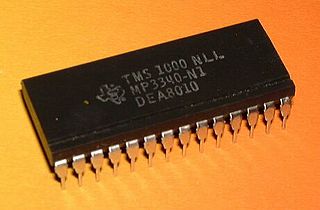
A microprocessor is a computer processor for which the data processing logic and control is included on a single integrated circuit (IC), or a small number of ICs. The microprocessor contains the arithmetic, logic, and control circuitry required to perform the functions of a computer's central processing unit (CPU). The IC is capable of interpreting and executing program instructions and performing arithmetic operations. The microprocessor is a multipurpose, clock-driven, register-based, digital integrated circuit that accepts binary data as input, processes it according to instructions stored in its memory, and provides results as output. Microprocessors contain both combinational logic and sequential digital logic, and operate on numbers and symbols represented in the binary number system.

MIPS Tech LLC, formerly MIPS Computer Systems, Inc. and MIPS Technologies, Inc., is an American fabless semiconductor design company that is most widely known for developing the MIPS architecture and a series of RISC CPU chips based on it. MIPS provides processor architectures and cores for digital home, networking, embedded, Internet of things and mobile applications.
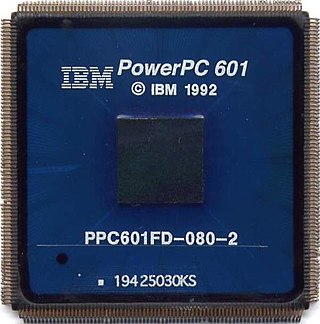
PowerPC is a reduced instruction set computer (RISC) instruction set architecture (ISA) created by the 1991 Apple–IBM–Motorola alliance, known as AIM. PowerPC, as an evolving instruction set, has been named Power ISA since 2006, while the old name lives on as a trademark for some implementations of Power Architecture–based processors.
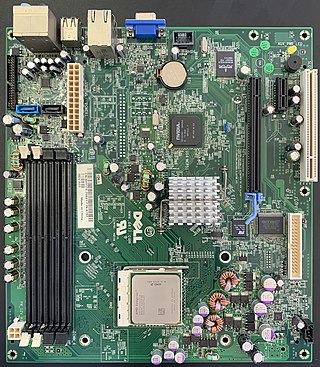
Computer engineering is a branch of electrical engineering that integrates several fields of electrical engineering, electronics engineering and computer science required to develop computer hardware and software. Computer engineering is referred to as Electrical and Computer engineering OR Computer Science and Engineering at some universities
Very long instruction word (VLIW) refers to instruction set architectures that are designed to exploit instruction-level parallelism (ILP). A VLIW processor allows programs to explicitly specify instructions to execute in parallel, whereas conventional central processing units (CPUs) mostly allow programs to specify instructions to execute in sequence only. VLIW is intended to allow higher performance without the complexity inherent in some other designs.
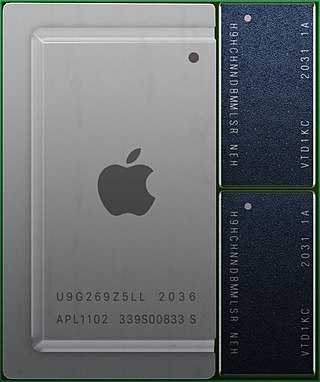
A system on a chip or system-on-chip is an integrated circuit that integrates most or all components of a computer or electronic system. These components usually include an on-chip central processing unit (CPU), memory interfaces, input/output devices and interfaces, and secondary storage interfaces, often alongside other components such as radio modems and a graphics processing unit (GPU) – all on a single substrate or microchip. SoCs may contain digital and also analog, mixed-signal and often radio frequency signal processing functions.

The Elbrus is a line of Soviet and Russian computer systems developed by the Lebedev Institute of Precision Mechanics and Computer Engineering. These computers are used in the space program, nuclear weapons research, and defense systems, as well as for theoretical and researching purposes, such as an experimental Refal and CLU translators.
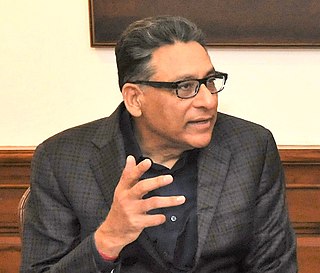
Vinod Dham is an Indian-American engineer, entrepreneur, and venture capitalist. He is known as the 'Father of the Pentium Chip' for his contribution to the development of Intel's Pentium micro-processor. He is also a mentor and advisor, and sits on the boards of companies, including startups funded through his India-based fund Indo-US Venture Partners, where he is the founding managing director.

Loongson is the name of a family of general-purpose, MIPS architecture-compatible, later in-house LoongArch architecture microprocessors, as well as the name of the Chinese fabless company that develops them. The processors are alternately called Godson processors, which is described as its academic name.
In electronic design, a semiconductor intellectual property core, IP core or IP block is a reusable unit of logic, cell, or integrated circuit layout design that is the intellectual property of one party. IP cores can be licensed to another party or owned and used by a single party. The term comes from the licensing of the patent or source code copyright that exists in the design. Designers of system on chip (SoC), application-specific integrated circuits (ASIC) and systems of field-programmable gate array (FPGA) logic can use IP cores as building blocks.

The Centre for Development of Advanced Computing (C-DAC) is an Indian autonomous scientific society, operating under the Ministry of Electronics and Information Technology.

The Centre for Development of Advanced Computing, Thiruvananthapuram (C-DAC[T]) is a branch of the Indian Centre for Development of Advanced Computing based in Thiruvananthapuram.
Advanced Numerical Research and Analysis Group (ANURAG) is a laboratory of the Defence Research and Development Organisation (DRDO). Located in Kanchanbagh, Hyderabad, it is involved in the development of computing solutions for numerical analysis and their use in other DRDO projects.
IBM POWER is a reduced instruction set computer (RISC) instruction set architecture (ISA) developed by IBM. The name is an acronym for Performance Optimization With Enhanced RISC.
RISC-V is an open standard instruction set architecture (ISA) based on established reduced instruction set computer (RISC) principles. The project began in 2010 at the University of California, Berkeley, transferred to the RISC-V Foundation in 2015, and on to RISC-V International, a Swiss non-profit entity, in November 2019. Like several other RISC ISAs, e.g. Amber (ARMv2) or OpenRISC, RISC-V is offered under royalty-free open-source licenses. The documents defining the RISC-V instruction set architecture (ISA) are offered under a Creative Commons license or a BSD License.
GigaDevice Semiconductor is a Chinese NOR flash memory designer. It also produces microcontrollers, some of them are based on the ARM architecture, and other on the RISC-V architecture.

SiFive, Inc. is an American fabless semiconductor company and provider of commercial RISC-V processors and silicon chips based on the RISC-V instruction set architecture (ISA). Its products include cores, SoCs, IPs, and development boards.

Shakti is an open-source initiative by the Reconfigurable Intelligent Systems Engineering (RISE) group at Indian Institute of Technology, Madras to develop the first indigenous Indian industrial-grade processor. The aims of the Shakti initiative include building an open source production-grade processor, complete systems on a chip (SoCs), microprocessor development boards, and a Shakti-based software platform. The main focus of the team is computer architecture research to develop SoCs, which are competitive with commercial offerings in the market in area, power, and performance. The source code for Shakti is open-sourced under the Modified BSD License. The project was funded by the Ministry of Electronics and Information Technology (MeITY), Government of India.
Chisel is an open-source hardware description language (HDL) used to describe digital electronics and circuits at the register-transfer level.











